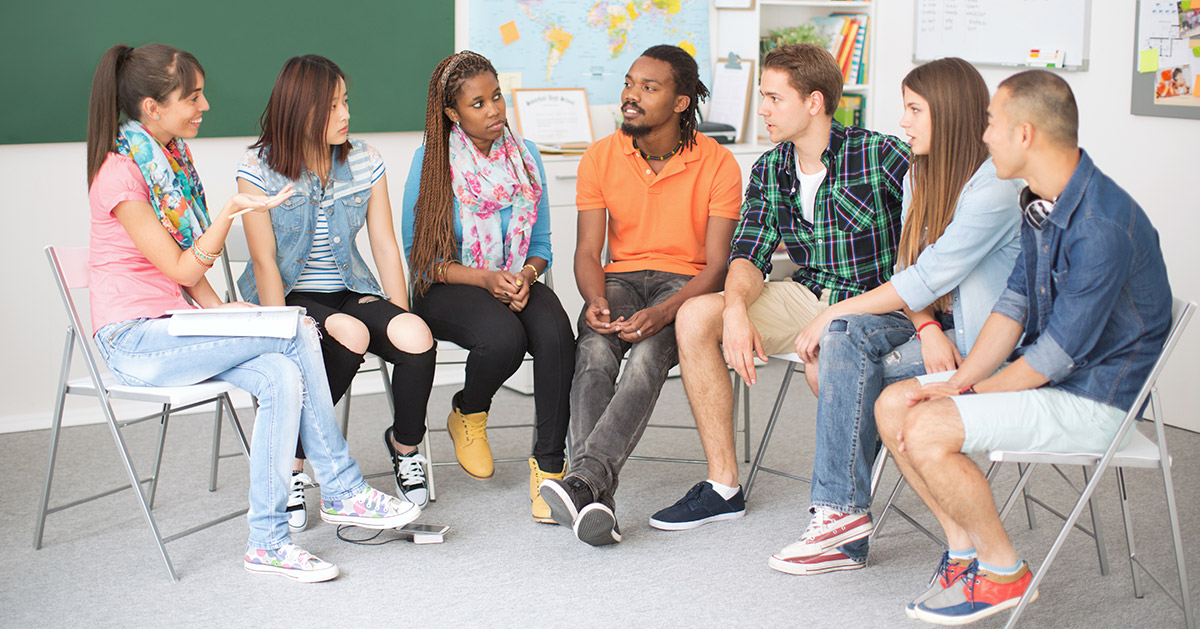
Restorative practices are helping schools move away from punitive practices to more therapeutic practices for everything from behavioral issues to counseling and treating trauma to classroom management.
Circle talks have become a staple of the restorative classroom, lowering suspensions in favor of social-emotional learning strategies to foster student, teacher, and family relationships.
Why circles?
When a student is in trouble, they often find themselves speaking to an adult sitting across a desk. This transmits a signal of authority from the adult and can put the child on the defensive. In class, the norm is often students sitting in rows with an authoritative teacher standing in front of them; and school can be rife with power struggles, with the adult seen as the moral authority.
Circles remove the unnerving concepts of authority and punishment and physically open up participants to face one another without barriers. “Classroom circles support the two main goals of restorative practices: building community; and responding to harms through dialogue that sets things right,” says M. Amos Clifford, a counselor from the University of San Francisco with over 40 years of experience in education.
- In New York City, schools that participated in the Morningside Center’s restorative practices training and coaching programs between 2012 and 2016 saw a 72% drop in suspensions (compared to 46% for the city overall during that period).
- In Chicago, after introducing restorative practices in the 2013-14 school year, 16% of high school students received an out-of-school suspension (OSS), down from 23% in 2008-9.
- In Los Angeles, a 2016 report found that restorative-justice programs meant a 92% decrease in the number of days lost to suspensions.
Social-emotional learning activities for the classroom
The impact is marked. Here’s a look at three of the most popular types of circle talks:
Community discussions
A great way to get students into a circle talk habit is by conducting community discussions regularly. “Community building doesn’t have to wait until a problem arises — it can be a time of offering positive encouragement as well or at the beginning of the year to help build bonds of commonality within the classroom,” says Ryan Wheeler in his piece “Circling Up for Community Building”.
Discussion circles can be fun, letting students tackle topics, share ideas, debate, and laugh together. And they can also be healing, allowing students to discuss difficult content and express their feelings in a safe space.
Circles can be practiced with both younger and older students. For example, a circle works well in elementary classrooms while gathered together in a circle on a cozy rug. Circles also work well in a high school advisory classroom, sitting in a circle of chairs. The object for the teacher is to facilitate discussion, but not to rule it. And often, a teacher needn’t be the facilitator at all, serving as an observer only. It’s a good idea to have some conversation starter questions at the ready and a talking piece to pass around.
Restorative circles
When misbehavior happens or social issues arise, restorative circles can get to the root of the problem, rather than merely punishing those involved. Restorative Circles can be done with a group of trained peer mediators, counselors, a mix of student community members, or even within a class. Students learn to discuss their issues, listen to different perspectives and come to peaceful agreements. “Within the circle, participants develop and practice skills in communication, relationship-building, empathy, democratic decision-making, conflict resolution, and problem-solving,” according to the Morningside Center for Teaching Social Responsibility. Sometimes, more than one circle is needed to provide long-term solutions to deeper issues.
Family circles
Another popular form of a restorative circle is the family circle. This can include school counselors, teachers, students, and their families to discuss an incident, its triggers, its impacts, and how to move forward.
Family group conferencing is another model of restorative practice that brings together the offender, service providers, family members, and sometimes the victim, to come up with a plan to help the offender repair harm and create a plan for change (Macgowan & Pennell, 2001). Instead of parents being called in and simply told the punishment their student will receive after an incident, family circles allow for a more conversational practice of healing for everyone involved. Incorporating family circles into your school’s disciplinary plan elevates the role of families as community partners.
The magic of circle talk is in giving students a voice in their education, models for healthy expression, and opportunities for long-term conflict resolution.
Jennifer L.M. Gunn spent 10 years in newspaper and magazine publishing before moving to public education. She is a curriculum designer, teaching coach, and high school educator in New York City. She is also cofounder of the annual EDxEDNYC Education Conference for teacher-led innovation, and regularly presents at conferences on the topics of adolescent literacy, leadership, and education innovation.
